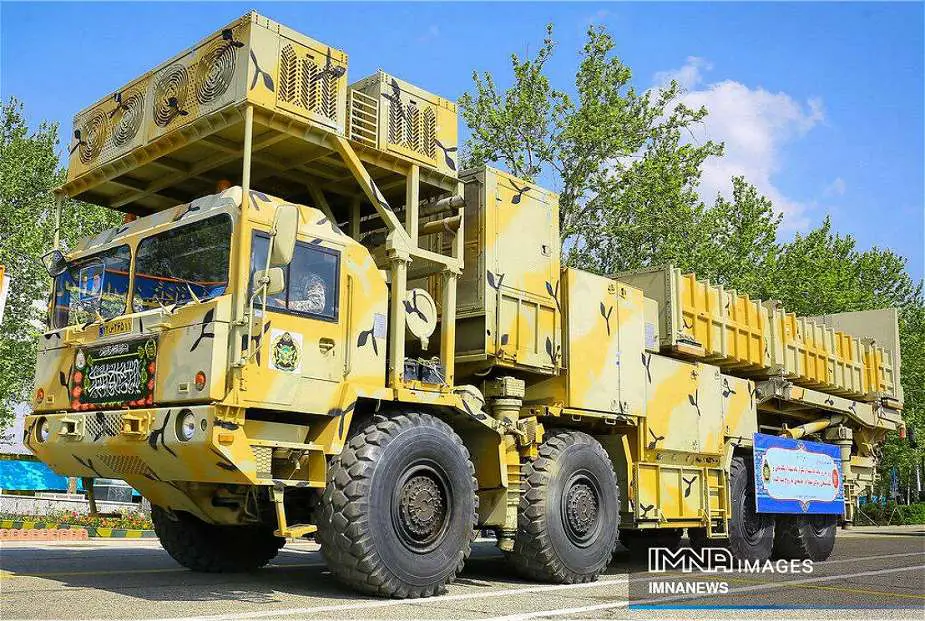During a military parade held on April 17, 2024, to mark National Army Day, Iran unveiled a new version of its Bavar-373 mounted on an 8x8 truck chassis, MZKT-791300, designed and manufactured in Belarus. The new version will have the same combat capabilities as the Russian S-400 air defense missile system, capable of intercepting fifth-generation fighter jets, including the American F-35 stealth aircraft.
Follow Army Recognition on Google News at this link

During a military that was held on April 17, 2024, Iran displayed an advanced version of its locally-made Bavar-373 air defense missile system. (Picture source IMNA News)
The Bavar-373 is a mobile long-range air defense system developed by Iran, as a competitor of the latest version of Russia's S-300 air defense system. It was officially introduced at a ceremony attended by the Iranian President Hassan Rouhani on August 22, 2019. An enhanced version of the system was unveiled in 2022. Citing information from the Iranian defense industry, the new version of the Bavar-373 is comparable to the Russian S-400 air defense missile system, claiming it can intercept fifth-generation fighter jets, including the American F-35 stealth aircraft.
The Bavar-373 is an air defense missile system designed to detect and intercept incoming missiles, drones, and aircraft at long ranges and high altitudes, and is intended to protect Iranian territory and strategic assets from air and missile attacks. The air defense system includes several components including radar, optical sensors, and command and control systems to detect, track, and intercept targets.
The system is said to include several different assets and components, including TEL (Transporter Erector Launcher) vehicles, Meraj-4 road-mobile S-band early warning 3D AESA (Active Electronically Scanned Array) radar, acquisition radar, and command post. The system may also include other assets, such as optical sensors, cameras, and data link systems that are used to support the detection and tracking of targets.
The Bavar-373 is able to launch the Iranian-made Sayyad-4B which is an upgraded version of the Sayyad-4 missile a two-stage, solid-fueled interceptor missile. The missile is designed to engage and intercept incoming aerial targets at ranges of up to 300 km, and at an altitude of up to 120 km.
The Sayyad-4B missile reportedly features an improved seeker, a new guidance and control system, and an advanced warhead. These improvements are intended to increase the missile's range, accuracy, and effectiveness against a wide range of targets, including cruise missiles, drones, and aircraft.
The development of Iran's defense industry has been significantly shaped by international collaborations and the impact of sanctions. Historically, Iran's defense sector relied heavily on imports from countries like the United States and Western European nations until the 1979 Islamic Revolution. After the revolution, ensuing sanctions, particularly from the US, compelled Iran to pursue self-reliance in defense capabilities.
During the Iran-Iraq War in the 1980s, the necessity for a robust defense industry became more pronounced due to the military embargo imposed by many countries. This period marked the beginning of Iran's efforts to develop its own weapons and military technology. The country established organizations like the Defense Industries Organization (DIO) to oversee domestic production.
Post-1990s, Iran sought technical cooperation and arms from Russia and China, who were less inhibited by Western sanctions. This collaboration included the transfer of technology and expertise, particularly in areas like missile technology and air defense systems. The acquisition of technology from these countries enabled Iran to develop systems such as the Bavar-373, which is similar to Russia’s S-300 system.
The continuous imposition of international sanctions has further driven Iran to become more self-sufficient. Sanctions have often targeted Iran's access to cutting-edge technology and hardware, making indigenous development not just a priority but a necessity. As a result, Iran has invested heavily in its local defense industry, leading to advancements in various sectors including missile technology, drones, and naval capabilities.
Despite challenges, Iran has demonstrated considerable progress in its defense sector, occasionally unveiling sophisticated systems that suggest a growing proficiency in technology adaptation and innovation, often claimed to be achieved through internal resources and occasional collaborations with countries like Russia and Belarus.
Defense News April 2024
















